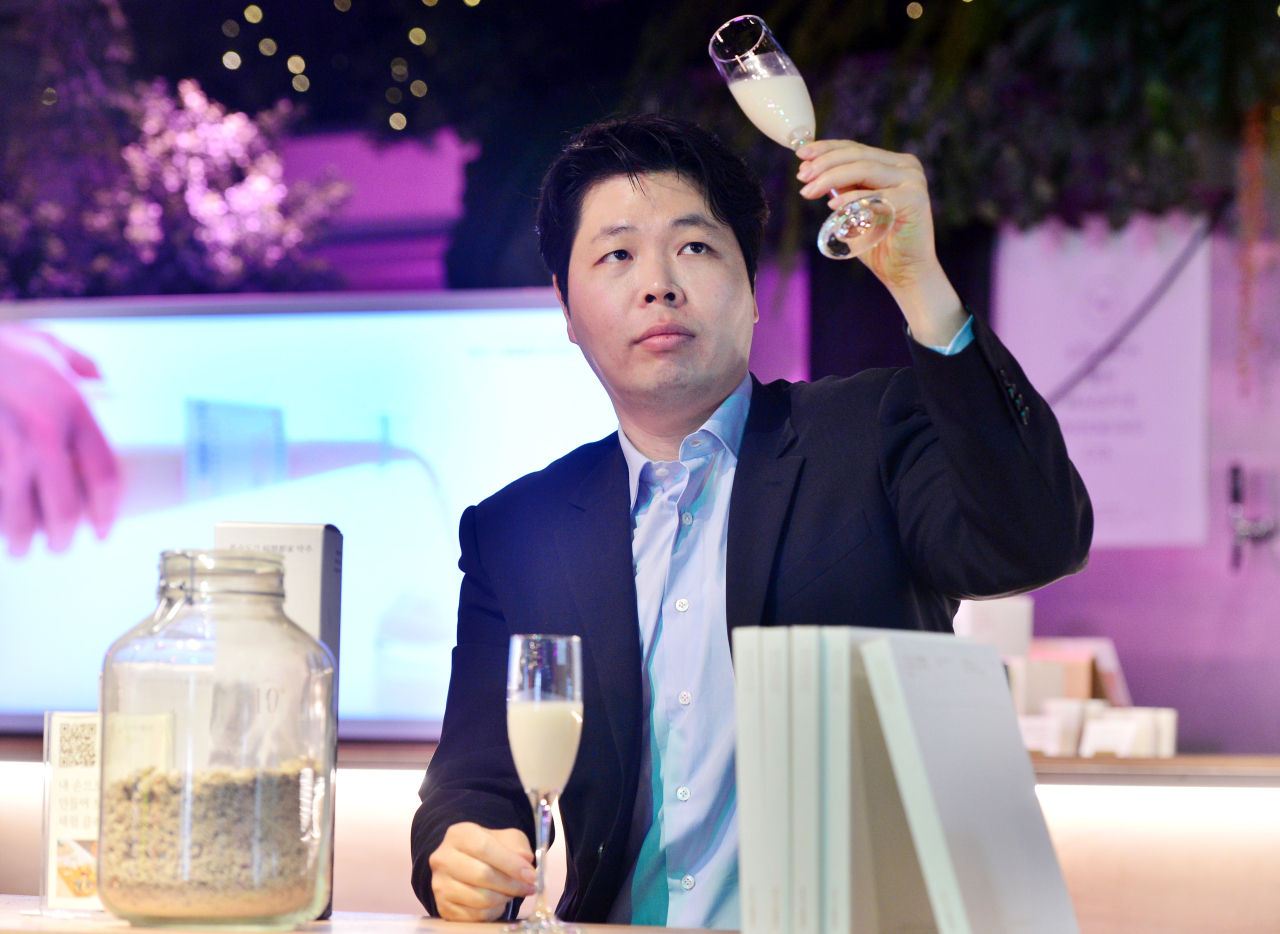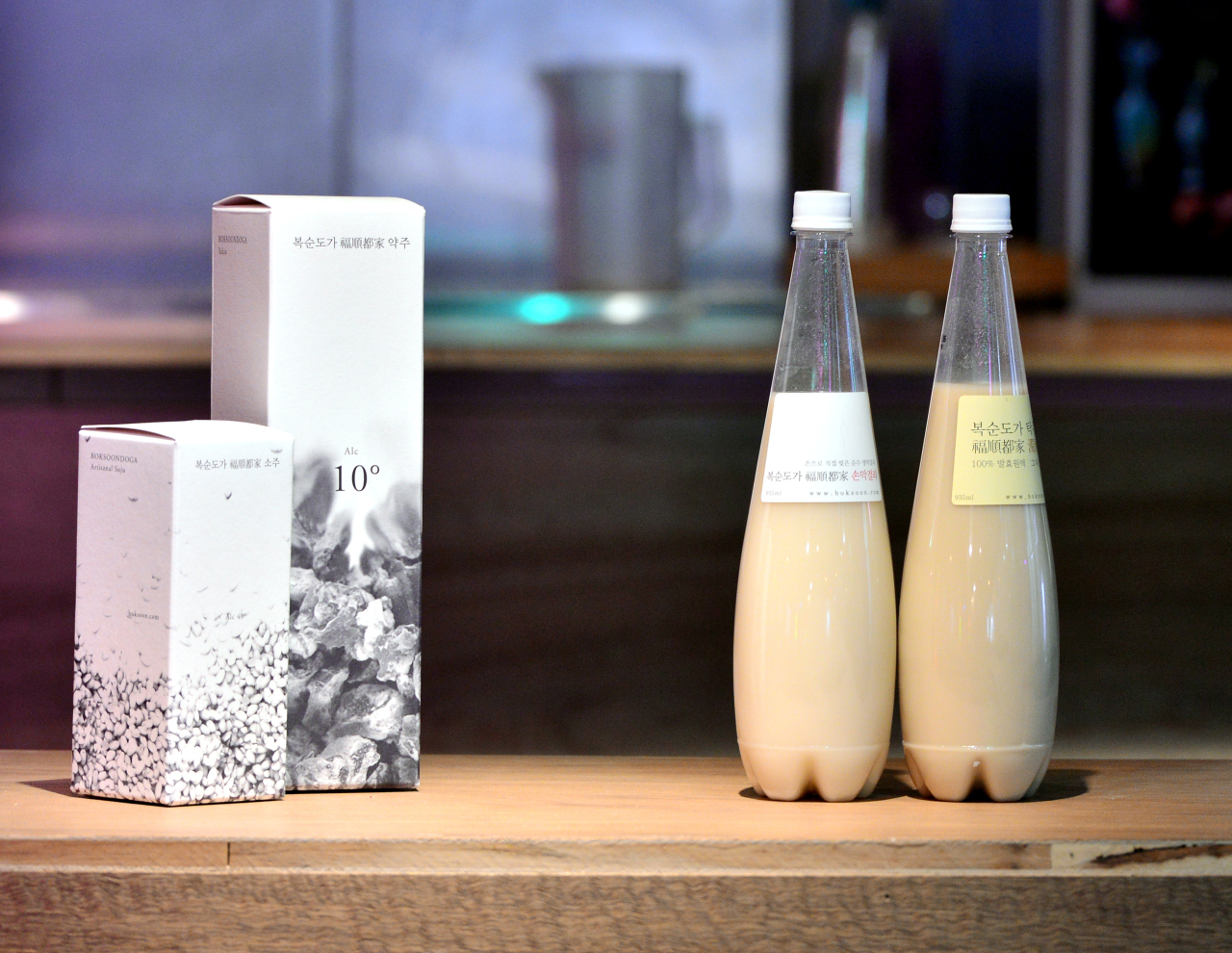[Herald Interview] Brewery serves up sparkling makgeolli in blend of tradition and modernity
A bubbly spin on Korea’s rice wine could modernize tradition and help farmers, says CEO
By Yim Hyun-suPublished : April 1, 2021 - 16:42

Makgeolli, a centuries-old traditional Korean rice wine, is enjoying its new life as a trendy and premium drink as of late.
Easily found at convenience stores and casual dining restaurants in Korea, it was once thought to be an “old man’s drink” over its affordability and stereotypes surrounding it.
But one man’s journey to revolutionize makgeolli and give it a more youthful and upscale makeover seems to have paid off in triggering a trend in recent year. The Korea Agro-Fisheries & Food Trade Corp. (aT) noted there has been a surge in demand for premium takju, an alcoholic beverage category that includes makgeolli, among young people in its 2020 report.
Despite the premium image, brewery Boksoondoga Corps CEO Kim Min-kyu said his makgeolli had a humble beginning, originating from his family’s recipe. His family, who are based in the southeastern city of Ulsan, did not own a brewery and used to make makgeolli for their own consumption.
“It began as a homemade makgeolli that was passed down generation after generation,” Kim told The Korea Herald during a recent interview at Boksoondoga Nodeul Island, a lounge bar located near Hangang Bridge in Seoul.
“The traditional way of making it is to keep the fermentation process longer, which as a result makes the makgeolli more carbonated. While the excessive bubbliness would normally be removed, we decided to keep it and embrace it by designing a bottle and branding our drink in a specific way,” said Kim, who is also a trained architect.
“Often, people say that Boksoondoga is the ‘original sparkling makgeolli.’ But I believe what we did is putting a contemporary spin on our family’s traditional recipe rather than making something brand new out of nowhere,” Kim added.
Though he now heads a company that sells an average of 1,000 bottles of sparkling makgeolli each day, Kim and his mathematician brother Kim Min-kook, embarked on the project with the idea of helping their parents.
“At first, we wanted to help our parents do what they enjoy. But it was actually people around us who suggested we do this for a living as they thought our family’s makgeolli was too good to be enjoyed only by people in town,” Kim said.
When Kim came back to Korea after spending over a decade in the US, he came up with the idea of marketing the beverage -- which is usually served in shallow tin bowls -- as sparkling makgeolli to drink in a champagne glass.
“When I came back to South Korea after studying in the US for 13 years, I felt that the country was very cosmopolitan, one that is quick to keep up and engage with trends in cities like New York, Tokyo, Paris and other places in the world.
“But when I traveled to the countryside, I felt that good things in cities did not exist there. It also felt true the other way around.”
Easily found at convenience stores and casual dining restaurants in Korea, it was once thought to be an “old man’s drink” over its affordability and stereotypes surrounding it.
But one man’s journey to revolutionize makgeolli and give it a more youthful and upscale makeover seems to have paid off in triggering a trend in recent year. The Korea Agro-Fisheries & Food Trade Corp. (aT) noted there has been a surge in demand for premium takju, an alcoholic beverage category that includes makgeolli, among young people in its 2020 report.
Despite the premium image, brewery Boksoondoga Corps CEO Kim Min-kyu said his makgeolli had a humble beginning, originating from his family’s recipe. His family, who are based in the southeastern city of Ulsan, did not own a brewery and used to make makgeolli for their own consumption.
“It began as a homemade makgeolli that was passed down generation after generation,” Kim told The Korea Herald during a recent interview at Boksoondoga Nodeul Island, a lounge bar located near Hangang Bridge in Seoul.
“The traditional way of making it is to keep the fermentation process longer, which as a result makes the makgeolli more carbonated. While the excessive bubbliness would normally be removed, we decided to keep it and embrace it by designing a bottle and branding our drink in a specific way,” said Kim, who is also a trained architect.
“Often, people say that Boksoondoga is the ‘original sparkling makgeolli.’ But I believe what we did is putting a contemporary spin on our family’s traditional recipe rather than making something brand new out of nowhere,” Kim added.
Though he now heads a company that sells an average of 1,000 bottles of sparkling makgeolli each day, Kim and his mathematician brother Kim Min-kook, embarked on the project with the idea of helping their parents.
“At first, we wanted to help our parents do what they enjoy. But it was actually people around us who suggested we do this for a living as they thought our family’s makgeolli was too good to be enjoyed only by people in town,” Kim said.
When Kim came back to Korea after spending over a decade in the US, he came up with the idea of marketing the beverage -- which is usually served in shallow tin bowls -- as sparkling makgeolli to drink in a champagne glass.
“When I came back to South Korea after studying in the US for 13 years, I felt that the country was very cosmopolitan, one that is quick to keep up and engage with trends in cities like New York, Tokyo, Paris and other places in the world.
“But when I traveled to the countryside, I felt that good things in cities did not exist there. It also felt true the other way around.”

The Ulsan native saw it as an opportunity for him to bridge that urban-rural gap.
“There was a real sense of miscommunication between the two places and it was when I thought hard how I could connect them and engage them with each other that I decided to modernize makgeolli and how to take a different approach to traditional alcohol drinks in general.”
Seeing drinks with a history thrive in other countries also motivated him.
“Compared to sake, wine or beer, I think, traditional drinks are uniquely underappreciated in Korea. Though more people are noticing them and there have been more brands lately, I do believe the market still has so much room for growth.”
Data from the government agency aT showed that the market for traditional alcoholic drinks including locally-made makgeolli increased from 45.6 billion won ($40.4 million) in 2018 to 53.1 billion won in 2019.
In 2019, makgeolli accounted for 5 percent of South Korea’s alcoholic beverage market, though not all makgeolli products are considered “traditional” as the label is only given to those that go through a specific process.
In a recent report, aT noted that makgeolli’s rise in popularity was in part thanks to more consumers moving away from drinking just soju and beer. The report also highlighted a particularly high demand for sparkling makgeolli.
As part of an effort to boost the market, the government also allows the sale of traditional alcoholic beverages online -- a privilege not enjoyed by other types of alcohol such as beer or whisky.
With all the positive signs in recent years, however, Kim said the industry still has a long way to go.
“Quantity is great but quality matters too in terms of market growth,” he said before adding, “I like both affordable and premium makgeolli but the market needs to be more diversified.”
On top of being tasty, Kim also says makgeolli can be one way to keep rice farming afloat as the country’s rice consumption continues to fall. According to Statistics Korea, South Koreans consumed an average of 57.7 kilograms of rice per person last year, nearly half of the amount consumed in 1990 -- 119.6 kilograms.
“Our diet has changed and more people consume wheat through foods such as pizza and bread. And I’ve seen with my own eyes how farmers sometimes give up on harvesting rice. It breaks my heart,” Kim said.
“The government has tried to downsize the scale of rice farming which can be a solution on its own. But in my view, these farmers are often not happy even after getting financial incentives and sell their farmland since farming is what they had been doing their whole life,” he added.
“I think both the local and central government can do more to help grow the traditional alcoholic beverage market. When the domestic market thrives, I am sure the brands will receive more recognition abroad too.”
“There was a real sense of miscommunication between the two places and it was when I thought hard how I could connect them and engage them with each other that I decided to modernize makgeolli and how to take a different approach to traditional alcohol drinks in general.”
Seeing drinks with a history thrive in other countries also motivated him.
“Compared to sake, wine or beer, I think, traditional drinks are uniquely underappreciated in Korea. Though more people are noticing them and there have been more brands lately, I do believe the market still has so much room for growth.”
Data from the government agency aT showed that the market for traditional alcoholic drinks including locally-made makgeolli increased from 45.6 billion won ($40.4 million) in 2018 to 53.1 billion won in 2019.
In 2019, makgeolli accounted for 5 percent of South Korea’s alcoholic beverage market, though not all makgeolli products are considered “traditional” as the label is only given to those that go through a specific process.
In a recent report, aT noted that makgeolli’s rise in popularity was in part thanks to more consumers moving away from drinking just soju and beer. The report also highlighted a particularly high demand for sparkling makgeolli.
As part of an effort to boost the market, the government also allows the sale of traditional alcoholic beverages online -- a privilege not enjoyed by other types of alcohol such as beer or whisky.
With all the positive signs in recent years, however, Kim said the industry still has a long way to go.
“Quantity is great but quality matters too in terms of market growth,” he said before adding, “I like both affordable and premium makgeolli but the market needs to be more diversified.”
On top of being tasty, Kim also says makgeolli can be one way to keep rice farming afloat as the country’s rice consumption continues to fall. According to Statistics Korea, South Koreans consumed an average of 57.7 kilograms of rice per person last year, nearly half of the amount consumed in 1990 -- 119.6 kilograms.
“Our diet has changed and more people consume wheat through foods such as pizza and bread. And I’ve seen with my own eyes how farmers sometimes give up on harvesting rice. It breaks my heart,” Kim said.
“The government has tried to downsize the scale of rice farming which can be a solution on its own. But in my view, these farmers are often not happy even after getting financial incentives and sell their farmland since farming is what they had been doing their whole life,” he added.
“I think both the local and central government can do more to help grow the traditional alcoholic beverage market. When the domestic market thrives, I am sure the brands will receive more recognition abroad too.”
By Yim Hyun-su (hyunsu@heraldcorp.com)

















![[KH Explains] Hyundai's full hybrid edge to pay off amid slow transition to pure EVs](http://res.heraldm.com/phpwas/restmb_idxmake.php?idx=652&simg=/content/image/2024/04/18/20240418050645_0.jpg&u=20240418181020)

![[Today’s K-pop] Zico drops snippet of collaboration with Jennie](http://res.heraldm.com/phpwas/restmb_idxmake.php?idx=642&simg=/content/image/2024/04/18/20240418050702_0.jpg&u=)